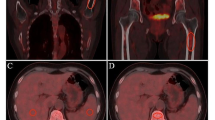Abstract.
Conventional skeletal radiography and bone scan have certain limitations in the initial evaluation of bone and bone marrow lesions in multiple myeloma (MM). In this study we investigated the value of bone marrow immunoscintigraphy (BMIS) using anti-granulocyte monoclonal antibody (AGA) for the diagnosis of bone involvement of MM, in comparison with bone scan and skeletal radiography. Whole-body BMIS using technetium-99m-labelled AGA was performed in 22 MM patients (15 male, 7 female) and the imaging findings compared with those of skeletal radiography and 99mTc-methylene diphosphonate bone scan. The findings of bone marrow aspiration and serum biochemical findings were also compared with BMIS findings. Abnormal findings of BMIS were defined as presence of a focal photon defect in the axial skeleton or expansion of peripheral bone marrow. A total of 124 focal lesions were detected in 19 subjects (86%) by skeletal radiography, bone scan or BMIS. BMIS detected 92 lesions (74%) in 19 subjects, whereas skeletal radiography detected 58 focal lesions (47%) in 14 and bone scan 40 lesions (32%) in 11. Fifty-one (41%) of the 124 lesions were only seen on BMIS. Spine and pelvic lesions were better visualised by BMIS, whereas skull lesions were better seen with skeletal radiography, and bone scan detected more lesions in the ribs. Marrow expansion was noted in 15 subjects (68%) on BMIS, and its grade correlated with marrow cellularity and myeloma cell percentage in bone marrow aspirates (P=0.0055 and P=0.0541, respectively). BMIS revealed abnormal lesions in one of three stage II patients and 17 out of 19 stage III patients. The number of lesions of the thoracolumbar vertebrae on BMIS was correlated with cellularity (P=0.0393), but not with myeloma cell percentage (P=0.1262). These findings suggest that the results of BMIS with 99mTc-labelled AGA correlate with clinical stage, and thus reflect the functional status of bone marrow in MM patients. BMIS might be useful for the detection of bone involvement of MM when skeletal radiography or bone scan is inconclusive, especially for vertebral lesions.
Similar content being viewed by others
Author information
Authors and Affiliations
Additional information
Received 28 July and in revised form 2 December 2001
Electronic Publication
Rights and permissions
About this article
Cite this article
Sohn, SK., Ahn, BC., Lee, SW. et al. Bone marrow immunoscintigraphy using technetium-99m anti-granulocyte antibody in multiple myeloma. Eur J Nucl Med 29, 591–596 (2002). https://doi.org/10.1007/s00259-001-0747-4
Published:
Issue Date:
DOI: https://doi.org/10.1007/s00259-001-0747-4




